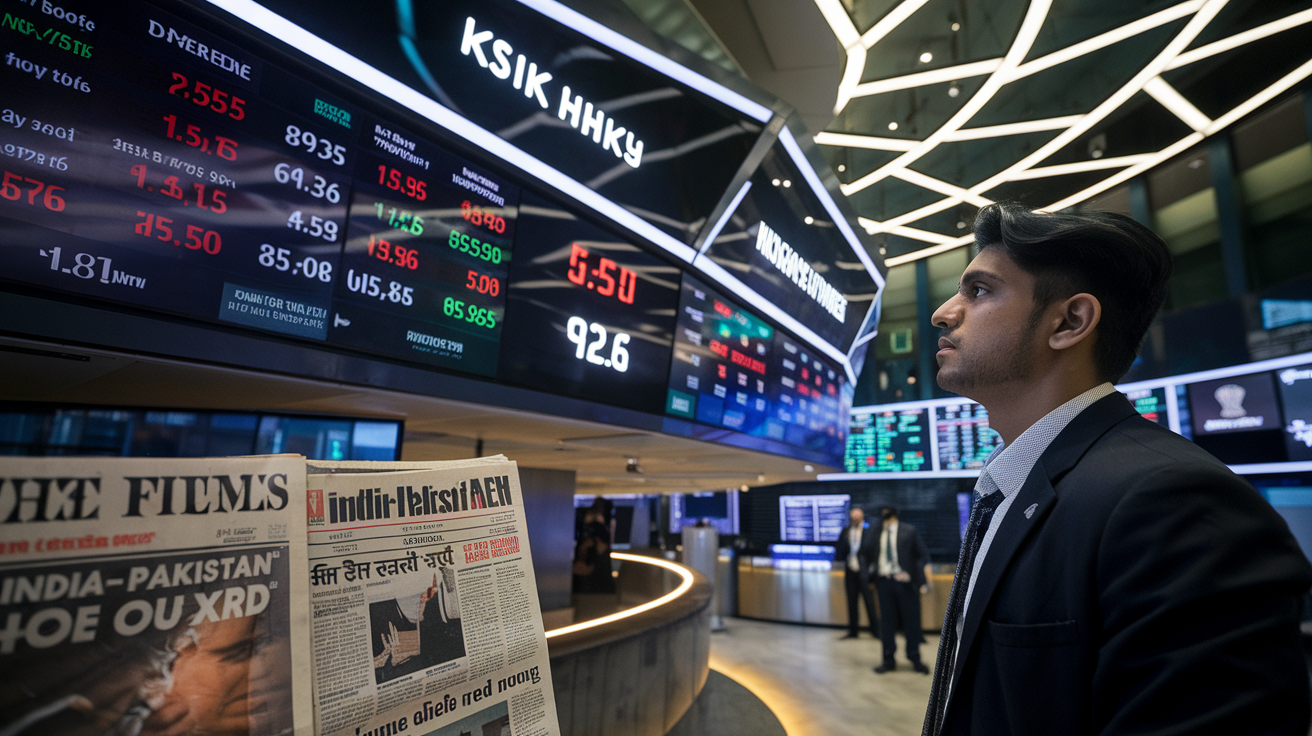How India-Pakistan War Could Reshape the Indian Stock Market
How India-Pakistan War Could Reshape the Indian Stock Market
How India-Pakistan War Could Reshape the Indian Stock Market
As tensions escalate between nuclear neighbors, Pakistan has suspended the Shimla Agreement and closed its airspace to Indian flights – dramatic moves that sent shockwaves through financial markets. While Pakistan’s stock market plummeted by a staggering 25,000 points over just two days, India’s markets have shown remarkable resilience. The Sensex closed down just 588 points at 79,212.53 despite witnessing intraday losses exceeding 1,100 points. This stark contrast raises a critical question: How would an actual conflict reshape India’s economic landscape?
The geopolitical chess game is intensifying with reports of “Operation Sindoor” and the Pahalgam terror attack, creating a perfect storm for market volatility. Financial experts are closely monitoring the situation as Pakistan’s economy—already dependent on IMF loans with a downgraded growth forecast of 2.6%—faces potential collapse while India maintains relative stability. What does this mean for your investments? In this analysis, we’ll examine the immediate market reactions to rising tensions, India’s economic vulnerabilities and strengths, and outline potential market scenarios if hostilities continue to escalate.
Current Geopolitical Tensions Between India and Pakistan

A. Suspension of Shimla Agreement by Pakistan
Pakistan’s sudden move to suspend the Shimla Agreement has sent shockwaves through the region. Signed in 1972 after the Bangladesh Liberation War, this agreement formed the backbone of India-Pakistan diplomatic relations for decades. Pakistan claims India violated the agreement through recent actions in Kashmir, but many analysts see this as a dramatic escalation rather than a justified response.
The suspension removes the framework that helped prevent full-scale conflicts between these nuclear neighbors. Markets hate uncertainty, and this development creates plenty of it.
B. Closure of Pakistani Airspace to Indian Flights
Adding fuel to the fire, Pakistan shut its airspace to all Indian commercial aircraft last week. This isn’t just posturing – it has real economic consequences. Airlines now must take longer routes, burning more fuel and increasing costs.
Remember 2019? When similar airspace restrictions happened, Indian airlines lost approximately $80 million in just three months. The aviation sector stocks dropped 7-12% during that period.
C. Operation Sindoor and Its Implications
Indian intelligence reportedly launched “Operation Sindoor” to counter terrorism originating from Pakistan. While details remain classified, security analysts believe it involves targeted intelligence gathering and potential cross-border operations.
The operation’s name has symbolic weight in Indian culture, and its public acknowledgment signals India’s willingness to take more aggressive counter-terrorism measures. Markets typically react nervously to such operations, especially if they risk military escalation.
D. Pahalgam Terror Attack
The recent terror attack in Pahalgam, a popular tourist destination in Kashmir, killed seven pilgrims and injured fifteen others. Indian officials have directly accused Pakistan-based terror groups of orchestrating the attack.
This tragedy has hardened public sentiment against Pakistan and put pressure on the Indian government to respond decisively. History shows that major terror incidents often trigger military responses, which create market volatility and sector-specific impacts, particularly in defense, insurance, and tourism stocks.
Immediate Market Reactions to Rising Tensions

A. Pakistan’s Stock Market 25,000-Point Plunge
The shock waves hit Karachi first. Pakistan’s benchmark KSE 100 index saw a jaw-dropping free-fall of nearly 25,000 points as tensions reached a boiling point between the nuclear neighbors. Investors scrambled for the exits as war drums grew louder, causing market capitalization to evaporate at an alarming rate.
This wasn’t your typical market correction – it was pure panic. Trading floors turned chaotic as sell orders overwhelmed the system, with virtually no buyers stepping in to stem the bleeding.
B. Trading Halt After 6% Drop in KSE 100 Index
Circuit breakers kicked in automatically after the KSE 100 plummeted 6% in a single session. Trading halted completely – a rare emergency measure designed to prevent complete market meltdown.
When trading resumed, the situation barely improved. The Pakistani rupee also took a beating against the dollar, compounding investor losses.
C. Indian Market’s Relative Resilience
Meanwhile in Mumbai, things looked surprisingly different. While the Indian markets certainly felt the tremors, they didn’t crumble. Defense stocks actually rallied on anticipated increased spending, while the broader indexes showed remarkable staying power.
Foreign institutional investors reduced exposure but didn’t flee entirely – a vote of confidence in India’s economic fundamentals despite the geopolitical storm.
D. Intraday Volatility in Sensex and Nifty50
That’s not to say Indian markets remained calm. Both Sensex and Nifty50 resembled roller coasters throughout trading sessions. Morning plunges were often followed by afternoon recoveries as investors tried to gauge actual war probability.
Sector rotation became the name of the game – money flowed from vulnerable sectors like tourism and aviation toward defensive plays like pharmaceuticals and consumer staples.
Economic Vulnerabilities and Strengths

A. Pakistan’s IMF Dependency
Pakistan’s economy teeters on a financial tightrope. The country just secured a $7 billion bailout from the IMF after months of negotiations. This dependency creates a major vulnerability – during wartime, these financial lifelines could freeze, sending their economy into freefall.
Foreign reserves in Pakistan hover around $9 billion – barely enough to cover two months of imports. Any military conflict would drain these reserves at alarming speed, potentially triggering currency collapse and hyperinflation.
B. India’s Stronger Economic Position
India stands on much firmer ground. With foreign reserves exceeding $600 billion, the Indian economy has substantial shock absorption capacity. This financial cushion gives Indian policymakers room to maneuver during crisis scenarios.
The numbers tell the story:
| Economic Indicator | India | Pakistan |
|---|---|---|
| Foreign Reserves | $600+ billion | ~$9 billion |
| GDP Size (2023) | $3.7 trillion | $376 billion |
| Inflation Rate | 5.1% | 23.1% |
C. Credit Risk Assessment by S&P Global
S&P Global rates India at BBB-, investment grade territory. Pakistan struggles with a CCC+ rating, deep in junk status. During conflict, these ratings would likely diverge further.
Indian bonds would likely see limited yield spikes, while Pakistani debt could become practically untradable as risk premiums soar.
D. Impact on Commodity Markets, Especially Gold
War fears typically drive gold prices skyward. Both nations rank among the world’s largest gold consumers. Indian investors historically flock to gold during uncertainty.
Oil prices would surge on regional instability, hitting Pakistan harder due to its complete import dependency versus India’s more diversified energy portfolio.
Long-Term Economic Forecast Differences

A. IMF’s Downgraded Growth Forecast for Pakistan
The numbers don’t lie, and Pakistan’s economy is struggling under the weight of serious fiscal challenges. The IMF recently slashed Pakistan’s growth forecast to a mere 2% for 2023-24, down from earlier projections. This downgrade stems from persistent inflation, dwindling foreign reserves, and a currency that’s been on a downward spiral.
Meanwhile, India continues to maintain a robust growth trajectory above 6%, creating a widening economic gap between the two nations that would only worsen dramatically in a conflict scenario.
B. World Bank’s Projections for Pakistan vs. India
The contrast couldn’t be more stark in World Bank forecasts:
| Economic Indicator | Pakistan | India |
|---|---|---|
| GDP Growth (2023-24) | ~2% | 6.3% |
| Foreign Reserves | Under $8 billion | Over $600 billion |
| Debt-to-GDP Ratio | ~70% | ~83% |
This economic disparity translates directly to war-bearing capacity. India’s economy is roughly ten times larger than Pakistan’s, giving it significantly more resources to sustain a prolonged conflict.
C. Inflation Trends and Economic Stability
Pakistan’s inflation has been running rampant at over 20% in recent months, while India has managed to keep inflation relatively controlled under 6%. This stability difference becomes crucial during wartime when economic pressures intensify.
D. Need for Structural Reforms in Pakistan
Pakistan desperately needs fundamental economic reforms to address its structural weaknesses. The country’s overreliance on external financing, inefficient tax collection (tax-to-GDP ratio below 10%), and energy sector inefficiencies create vulnerabilities that would be catastrophically exposed during conflict.
India’s more diversified economy and stronger institutional frameworks provide greater resilience against war-related economic shocks.
Potential Market Scenarios if Tensions Escalate

Potential Market Scenarios if Tensions Escalate
A. Impact on Trade and Business Relations
Trade between India and Pakistan would freeze almost overnight if war breaks out. The annual bilateral trade worth around $2 billion would vanish, hitting businesses that depend on cross-border commerce. Think textile manufacturers in Gujarat who source cotton from Pakistan, or Punjab farmers who sell their goods across the border.
Indian companies with Pakistani partnerships would face immediate operational challenges. Banks would freeze transactions, letters of credit would be revoked, and existing contracts would become unenforceable.
Many don’t realize that informal trade through third countries like UAE and Singapore (estimated at $5-10 billion annually) would also collapse, creating wider economic ripples than official numbers suggest.
B. Transportation and Logistics Disruptions
A war would slam the brakes on all cross-border movement. The Wagah-Attari border crossing would shut down, forcing traders to find alternative routes through other countries at 2-3x the cost.
Air space restrictions would force commercial airlines to reroute flights, adding hours to journey times and pushing up fuel costs. This hits not just India-Pakistan routes but flights to Europe and North America too.
Shipping would face similar challenges with naval blockades potentially restricting access to key ports. Insurance premiums for vessels operating in the region would skyrocket – costs that ultimately get passed to consumers.
C. Investment Flows and Foreign Direct Investment
War drums send foreign investors running for the exits. Portfolio investments would see immediate outflows as global fund managers reduce their India exposure to manage risk.
The Indian rupee would face significant pressure, potentially depreciating 10-15% against major currencies. The RBI would need to intervene, burning through foreign reserves to stabilize the currency.
Long-term FDI projects would hit pause as investors adopt a wait-and-see approach. The manufacturing and tech sectors, which have been attracting significant foreign capital, would feel this pinch most acutely.
D. Defense Sector and Military Spending Implications
Defense stocks would rally as government spending shifts toward military needs. Companies like Hindustan Aeronautics, Bharat Electronics, and Bharat Dynamics could see valuation jumps of 15-25%.
The government would likely increase defense allocation beyond the current 2% of GDP, potentially reaching 3-4% during active conflict. This additional spending would come at the expense of infrastructure and social welfare programs.
The longer-term impact might include the development of India’s domestic defense manufacturing capabilities, particularly if global sanctions restrict arms imports. This could create new investment opportunities while reshaping budget priorities for years to come.

The escalating tensions between India and Pakistan present significant implications for financial markets in both nations, with starkly different outcomes emerging. While Pakistan’s economy shows severe vulnerability—evidenced by the dramatic 25,000-point stock market decline over just two days and continued dependence on IMF support—India’s market has demonstrated notable resilience. Though the Sensex and Nifty experienced momentary turbulence, their recovery signals underlying economic strength that could withstand geopolitical pressures.
Investors should closely monitor these developments as they unfold, particularly regarding potential airspace restrictions and trade disruptions that could impact specific sectors. For those with exposure to the Indian market, maintaining a long-term perspective may prove beneficial, as historical patterns suggest the market’s ability to absorb geopolitical shocks. While uncertainty remains, India’s comparative economic stability positions its financial markets to potentially navigate this crisis more effectively than its neighbor.
